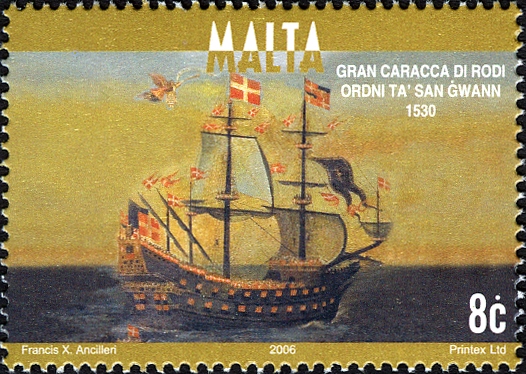
On 26 October 1530 Grand Master Philippe Villagers de Lisle Adam of the Sovereign Military Order of St. John arrived with 400 knights in three galleys, SANTA CROCE, SAN FILIPPO and SAN GIOVANNI, as overlords of the Maltese Islands which had been presented to them by the Emperor Charles V.
Malta was destined to become a secure base for the Order’s naval operations against the Turks. The knights at the time sailed one of the largest carracks, the SANT ANNA frequently referred to as the “Gran Caracas of Rudi”, which had a fighting complement of 300 besides 400 infantry and cavalry. This three-masted ship had a hull that tapered above the waterline and large castles fore and aft as shown in this 16th century painting exhibited at the Sanctuary Museum at Zabbar. She was destroyed in a fire a few years after the arrival of the Order in Malta.
The SANT ANNA belonged to a class of big ships, which were to fade away from the maritime scenario of the Mediterranean by the middle of the 16th century.
In fact the SANT ANNA was one of the last carracks to sail in the Mediterranean.
She was built in Villefrance-sur-Mer, France.
Launched towards the end of December 1522 in Nice. Ironically, it was the day in which the Hospitallars lost their island of Rhodes to the Ottoman Turks.
In fact the Knights of St John quit Rhodes in 1522 and spent the next eight years roaming until they finally settled down in Malta in 1530.
The carrack SANT ANNA had served during this period both as a man-of-war and a hostel, hosting distraught Knights.
The carrack SANT ANNA was one of the biggest ships roaming the Mediterranean at the time. It was so big and powerful that it could withstand an attack from a fifty strong galley squadron. It carried big guns on its main deck whilst the two upper decks were armed with small caliber guns. In fact the main armament of the carrack consisted of fifty big guns classed as culverins and reinforced cannons which were all distributed on the two main gun decks, on the bows, the stern and the waist of the ship. Short and at the same time heavily cast reinforced guns were located on the sides of the carrack.
The SANT ANNA also carried small caliber guns on its mast tops, whilst smaller guns called bombards, falcons and falconets were also fitted onto this ship. Such a powerful gun battery brought the Hospitallars historian Giacomo Bosio to state that the carrack was unsinkable even if attacked by a whole galley squadron.
Notwithstanding its huge hull indispensable for such a huge number of guns, the SANT ANNA behaved excellently under sail but its size constrained to a slow speed.
The carrack housed on the poop a big wooden chamber called the great council room, which was reserved, as the meeting place for the Grandmaster and his Council. The ship also had an oven so that the crew could be supplied with fresh baked bread. This was a luxury for those times. Most of its contemporary galleys could not afford any space for an oven and the crew had to satisfy themselves with hard biscuits.
Throughout its eighteen years at sea, the carrack was involved in some of the most spectacular Christian expeditions against the Barbary Coast.
In 1532 the carrack participated in the amphibious action against Coron.
On 30 May 1535 the carrack SANT ANNA sailed out of the Grand Harbour in Malta on an expedition against La Goletta in Tunis. Unfortunately, its massive size made the carrack sail slower than the other galleys, with the result that the carrack was left on its own at a distance. It was not possible for the galleys to tow the carrack. Eventually, the carrack succeeded in arriving at La Goletta to participate in the Christian attack on the Muslim fort.
The Muslim gunfire caused only minor damage to the carrack. On the other hand, as the carrack had the highest freeboard and the most powerful guns, it caused the greatest damage to the Muslims fortification. While firing over the galleys, the carrack protected them from the enemy’s fire. Moreover, the carrack served as a hospital ship.
During the bombardment wounded knights and soldiers were taken on board for medical assistance by the Knights infirmary staff.
The story of the carrack SANT ANNA came to an end in 1540. In that year, it was decided that the ship was to be laid up. It was left to rot in the Maltese Grand Harbour, meanwhile serving as a store and perhaps a hostel for distraught pilgrims and sailors.
Giacomo Bosio, one of the Hospitallers chroniclers speaks highly of the carrack as being the best floating fortress of the Mediterranean. Indeed, whenever it was employed against the enemy it won the day easily.
The great canvas that exists and is exhibited at the Zabbar Sanctuary Museum is the earliest testimony of the ship in Malta but unfortunately the representation is more consonant with the profile of a great galleon rather than that of a carrack.
Source: Copied from http://projects.um.edu.mt/navigationdus ... g.php.html
